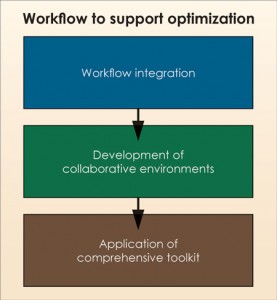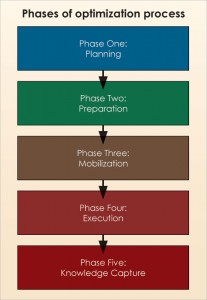No more silos: Drilling optimization requires integrated workflow
Optimized drilling is a moving target that demands a careful balance of people, process and technology; holistic approach may also drive restructuring of service contracts going forward
By Jeremy Greenwood, Rick Russell and James Bement, Halliburton

The oil and gas industry is under continual pressure to drive performance improvements. For drillers, this translates to meeting the dual challenges of creating the best possible wellbore at the lowest total construction cost. They must deliver the wellbore quickly, safely and to the required quality such that all subsequent well construction activities – casing, cementing and completing – take place with the highest efficiency for the long-term production benefit of the well.
The concept of drilling optimization has garnered a significant focus as a driver for performance enhancement. Since entering the industry lexicon over 60 years ago, the meaning of drilling optimization has evolved as the technical capabilities related to delivering performance have evolved.
Between the 1950s and 1970s, optimization focused on the mathematical modeling of drilling behavior and the wellbore environment. It then shifted to include software applications and real-time data capture in the 1980s, and tools for downhole drilling dynamics measurements in the 1990s.
Within the past decade, service companies have provided optimization services as discrete capabilities, placing engineers and equipment at the well site to mitigate the cost impact of unplanned events by identifying and reacting sooner to developing incidents; to respond to process breakdown during the drilling phase; or to determine the reasons for drilling problems, poor service quality or equipment failure.
Because it has been used in the past to refer to individual models, software, measurements and downhole equipment, the term optimization has become overused and its true goal – performance – is often overlooked.
Although optimizing the drilling process is a key part of improving performance, it should not be applied as a means of using discrete technologies to address a finite or fixed need. Instead, optimization is achieved through balancing conflicting requirements through the application of a comprehensive decision-making workflow that combines the most effective technologies and methods together such that the best drilling decision can be made from multiple options. Only in this way can true performance improvements be realized.
For their part, service companies have to position themselves as partners in the drilling operation that deliver the most efficient processes to drive overall cost reduction, rather than being merely the lowest-cost provider or a commodity supplier. Setting up these processes requires a great deal of effort to best leverage and link one’s people, services and technologies for maximum benefit.
Building a Framework
Optimizing drilling performance requires following a workflow that delivers the right combination of drilling services to address the specific challenges of the well to be drilled. This requires first a thorough understanding of the performance goals in terms of well delivery and production, the construction plan to achieve those goals and the drilling plan to meet the construction specifications.
With these goals clearly in mind, a workflow is developed that supports and delivers three optimization drivers:
• Workflow integration, designed to link traditionally siloed people and processes in an engineering workflow that allows all challenges to be completely understood, competing requirements to be balanced and the most economical solution to be identified.
• Development of collaborative environments, which are both physical and virtual workspaces that improve the integration and speed of planning and design, as well as interpretation and decision-making during drilling.
• Application of a comprehensive technology toolkit, which allows effective solutions to be realized and addresses key technology elements, including: drilling equipment, tools and fluids; modeling and analytical software; surface and downhole measurements; and real-time data transmission and infrastructure.

Putting the Process in Play
An optimization process should follow a sequential and interconnected series of phases that begins with planning. The planning phase requires a high level of integration between different technology disciplines to ensure that requirements of the entire drilling process, not just individual components, are understood. It requires close collaboration with the operator to model expected behavior, design or customize the required equipment, and develop a program that best addresses well construction needs. This phase also allows any performance limitations to be identified such that other operational options can be assessed and later implemented.
The next step of the process, preparation, allows the required resources and equipment to be selected and obtained for the well and the necessary support, maintenance and logistics requirements to be established.
The mobilization phase is next, which requires an efficient, globally integrated logistics chain to ensure that all equipment and services are available exactly when and as required for the execution phase.
During the execution phase, optimal drilling can be achieved only through an understanding of how each element impacts the entire system such that overall performance is not compromised. Execution adheres to two goals:
• Executing the plan and delivering performance by responding to the actual drilling conditions such that technical limits are continually pushed. This also addresses so-called invisible nonproductive time by improving procedures and avoiding unnecessary activities.
• Avoiding hazards and reducing the need to respond to unforeseen events and implement contingency plans.
The last step in the process, knowledge capture, requires effective and open communication, comprehensive knowledge management and easily accessible data storage. This step gathers the appropriate selected measurements, software models and input from real-time operating environments to drive further efficiencies during project execution.
Constantly Pushing the Boundaries
Historically, discussions on optimization’s successes have centered on one workable solution to a problem or a single step-change in performance. This mindset must change. Instead, optimizing performance should be seen as a continual examination and re-examination of all the factors that limit drilling performance. We, as an industry, must always ask what else can be done.
The end goal is always to meet or exceed production targets by delivering the well as efficiently, reliably and safely as possible. As this is achieved, the bar is raised to reach further performance improvements, presenting service providers with increasingly complex drilling objectives and, usually, more challenging economic constraints.
Viewed in this light, optimization is a continually moving target. The discrete technologies, products and services must still operate with the highest levels of service quality and reliability, but the entire systems design must be considered in terms of how the combination of equipment, fluids and drilling practices can best deliver the specific well objectives with the highest level of performance.
While the specific challenges will differ by geographic location and reservoir development needs, the fundamental requirements of drilling a wellbore are the same for every well. What is crucial is identifying the unique challenges and limits to performance in any situation. This requires a “model-measure-optimize” methodology that incorporates solid engineering capability to predict the expected performance conditions, analyze the drilling behavior in real time, validate or modify predictions, identify any limiting factors and select the most appropriate solutions such that optimal performance is achieved with minimal nonproductive time.
Shared Risks, Shared Rewards
Many operators are realizing the benefits that a holistic optimization approach has on their drilling programs. This has driven them to shift their thinking about how service contracts should be structured. The historical model of structuring commercial terms around dayrates and rentals is giving way to terms that favor and encourage performance improvements from their vendors. Factors including a clearer understanding of performance incentives, greater reliability on key performance indicators (KPIs) and the growth in project management in recent years have all contributed to a better understanding of the risks and requirements to optimize well construction performance, and the impact of the drilling component.
As a result, operators are increasingly setting performance metrics into their contracts that, if agreed upon by their service providers, promise to elevate the industry as a whole. An optimized drilling program provides a more cost-effective solution to the operator in terms of avoiding downtime or sub-optimal performance. The service provider that can deliver the highest levels of reliability and execute the job faster and more efficiently will also benefit from bonus schemes and the promise of work on future jobs. And as existing performance indicators are met and exceeded, they are replaced with higher standards and new KPIs, which the industry as a whole – operators and service providers alike – will strive to meet.
Conclusions
The industry’s continuing embrace of optimized drilling performance stresses a growing need for service providers to develop strategies that effectively balance their people, processes and technologies. This balance requires developing collaborative, rather than siloed, work environments to create an integrated workflow suited to deliver continuous process innovation and a fully optimized drilling process.
Halliburton has gone through a comprehensive review of our existing procedures to develop an optimized drilling performance initiative, which has positively impacted drilling activities on more than 200 wells around the globe in the past 12 months. We have developed, and continue to improve, the collaborative approach to deliver improved overall wellbore quality, production and net present value while also reducing time to production, overall costs and nonproductive time.




